
The Pelion Plains, in the middle of the Cradle Mountain-Lake St Clair National Park, are remote and stunningly beautiful. Some call them pristine wilderness. On the southern edge of the plains is the imposing two-storey edifice of New Pelion walkers’ hut. It is the newest and biggest of a series of huts that have stood in the area. More than a kilometre away is the more modest Old Pelion Hut. Built in 1917, it is said to be the first hut on the plains.
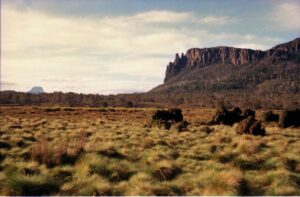
In fact, Aboriginal people made shelters on this country for thousands of years. Europeans built numerous huts well before Old Pelion. There were surveyors, graziers, bushmen, hunters, and prospectors at the Pelion Plains before bushwalkers made this country theirs. The older huts, and the people who occupied them, have been forgotten. It is time to add some more layers of history to the Pelion Plains.
The First Hut and the Railway – 1891
In 1891, the Pelion Plains came alive with activity and the first hut was built. Before the plains had been only known to a handful of bushmen, but the plains were suddenly inundated with explorers. The reason was the rich silver mines at Zeehan on the west coast and the desire for a railway to link them to the main towns of Tasmania.
Launceston proposed a route starting at Mole Creek. It had to navigate through the relatively unexplored mountains and valleys on its way to Zeehan. The survey teams engaged were provisioned via a new pack track and huts were built where they were needed.
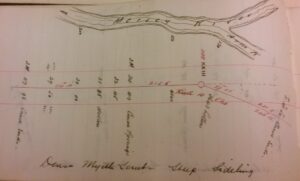
Local bushmen, one being the ubiquitous William Aylett, guided the surveyors who then chose a route to allow for the gentle grades, curves, bridges and tunnels that a railway would need. The surveyors took bearings, measured distances and filled field books with their detailed information.

The survey left the railway station at Mole Creek and worked its way into the Mersey River valley. By December 1890, the bushmen had reached the Pelion Plains.[1] The surveyors got there in April 1891.[2] Work continued until September when the survey was halted because of provisioning problems.[3]
Part of the legacy of the railway survey was a good pack track and a new hut on the Pelion Plains near where New Pelion Hut now stands.[4] The hut was probably built around April 1891 by the bushmen. It was crude; roughly hewn slabs for walls and a bark roof held down by logs. A large wooden chimney provided warmth and cooking. It was reported that the hut would ‘last some years’ and be a ‘traveller’s resting-house’.[5]
While the surveyors were still working, prospectors and hunters followed the pack track to the Pelion Plains. Undoubtably the new hut would have been put to good use. In May 1891, silver was discovered at Douglas Creek near where Old Pelion hut now stands. Mineral leases were taken up. This success created a small rush which drew more prospectors including bushman William Aylett.[6] In January 1892, additional leases were taken north of the first discovery.[7] But within two months, the rush had ended.
Hunters 1892 – 1896
Nothing was written about the railway survey hut for the next few years but it seems to have been adopted by hunters. Oral histories point to a number of people who took to hunting there. The earliest would have been Jerry Aylett (father of William). A tanning trough, or two, used for animal skins, apparently survived into the 1950s.[8]
The Next Huts and the Copper Mine – 1897
The next surge in interest, and the next huts came in the late 1890s. Another mineral rush on the West Coast, this time for copper at Mount Lyell, brought another survey to the Pelion Plains in November 1896. Edward George Innes was given the job of surveying the route of a track. Again, it was an overland route from Mole Creek to the west coast mineral fields. Prospectors followed the new survey to the Pelion Plains and created another rush.
The abandoned silver leases near Douglas Creek were revived as copper mines.[9] Others found coal near Paddys Nut. The old ramshackle railway survey hut was the only accommodation on the plains. It welcomed the new wave of surveyors, prospectors and promotors.
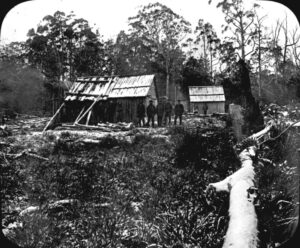
A new company, the Mount Pelion Consolidated Copper Company (the Copper Co.), was formed in September 1897 to develop the revitalised discovery. [10] By the end of November, two new huts had been built for the manager and the workers.[11] Stephen Spurling III photographed the Pelion Huts in March 1898. It tells an interesting story.
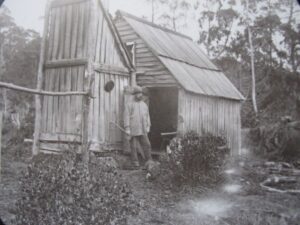
The neat hut on the right was for the manager. The single man standing in front of it is probably the mine manager, Brennan. The walls and roofs of the hut are made of palings (the line across the roof shows were two lengths overlap). The palings have been neatly made; uniform size and good finish. Photos, from 1901 of the inside of the hut, show that it has bunks for two people. It was well appointed with a window in the gable end over the fireplace. The standards of the day meant that managers received much better lodging than their workers.
The second hut, on the left, was a combination of the old railway survey hut and a new extension built for the workers. They stand outside of their hut. At the time it was reported that six men were working for the Copper Co. and the photographer Spurling had come with three packers.[14] The seven years since 1891 had taken a toll on the old hut. It appears to be propped up and it was missing sections of the roof. The neatly made extension, a copy of the manager’s hut, would have been crammed with bunks for the workers.
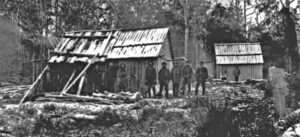
Despite the workings of the Copper Co. being over a kilometre away, they choose to build their new huts with the railway survey hut. The location clearly had advantages like; an existing hut, being well sheltered from the prevailing westerly weather and plenty of timber for building and firewood.
Blacksmiths Shops 1897, 98
As well as accommodation huts, the Copper Co. also needed blacksmith’s shops. Mining the hard rock blunted the miners’ tools, which needed to be heated and repointed. It is likely that a blacksmith’s shop was constructed in November 1897.[16] The smithy would have worked at near the mine.
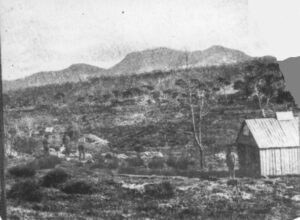
In January 1898, it was reported that shaft sinking had to be stopped ‘on account of the blacksmith not being able to keep the men in sharp tools’.[17] A second blacksmiths shop was built a month later when the operation moved to older workings on the northern side of the Pelion Plains.[18] Stephen Spurling III also photographed these in March 1898.
The blacksmith shop shows a high standard of construction with very neat paling walls and roof, similar to the Copper Co. accommodation huts. The front of the building was open and a vent in the middle of the roof allowed the smoke from the forge to escape.
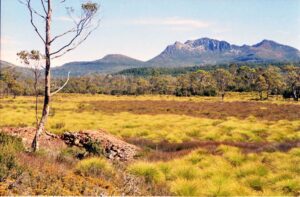
Despite the great hopes, the Copper Co. workings fell silent some time around July 1899.[19] [20] However, the area wasn’t abandoned as hunters and graziers were active on the Pelion Plains for many years. These were thought to be Paddy Harnett, George Sloane and Harry Glover.[21]
The Old Huts Erased
In 1912, the ‘old mining plant and sheds in the vicinity of Mount Pelion’ were reported as being destroyed by bush fire. [22] It seems that the two huts and two blacksmiths’ shops were wiped from the plains and from history.
In 1917, miners returned to the Pelion Plains and built Old Pelion Hut.
A series of walkers’ hut were built at New Pelion from the 1930s. Each succumbed to fire or old age. The current hut is the seventh on this spot, that is if the forgotten huts are remembered.
The Old Huts Forgotten
Bush fires destroyed physical evidence of the oldest huts on the Pelion Plains. But the oral traditions have kept echoes of their existence alive. The changing of the guard on the Pelion Plains from bushmen to bushwalkers also broke the transfer of the old stories. However, archival information and our many trips to this area allowed us to untangle the vagaries of the spoken histories that have been passed down and we have recovered this fascinating early history.
In a place with such a striking natural beauty it is easy for the human history to be overwhelmed. The early history may have been 130 years ago but it still has resonance today.
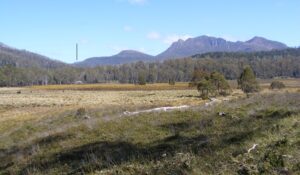
Copyright P Brown 2022
1 The Tasmanian, 27 Dec 1890.
2 Allan Stewart, Engineer in Charge – Mole Creek to Mount Zeehan Railway Survey, Hobart 19 Oct 1891. Parliamentary Papers 140/1891
In April the camp was then moved to Mount Pelion.
3 The Engineer following· up with the permanent work (Mr. W. H. Scott) pitched … his last (camp) on the River Forth (first branch) (now called Douglas Creek), when he was recalled at the end of September.
4 Both the map and a later description match the location as near New Pelion – Just beyond Lake Ayr the eastern branch of Forth (Douglas Creek) is reached … Near here is an old survey and miners’ camps formed during the boom time when the railway survey and Mole Creek Prospecting Association were in the vicinity. About a mile beyond is the present mining camp, where those prospecting mineral sections are working – Launceston Examiner, 26 Feb 1897
5 Alan Stewart, as per reference 2
6 The Tasmanian, 26 Dec 1891.
7 Chalmers, H (1892b), Diagram of mineral survey of leases No.1149 91M and 1150 91M, Tasmanian Department of Mines: Hobart, Tas.
8 Tom McCoy, entry in the Pelion Chalet logbook 1951-57, AA622/1/22 (TA); and interview with Wal Connell by Nic Haygarth 22 September 1997.
9 Launceston Examiner, 24 Nov 1896.
10 Launceston Examiner, 27 Sept 1897.
11 Launceston Examiner, 30 Nov 1897.
12 Stephen Spurling, Illustrated Supplement to Launceston Examiner, 9 July 1898
13 George Renison Bell, one of Tasmania’s most best prospectors, is pictured at the managers hut. https://www.mininghistory.asn.au/wp-content/uploads/4.-Haygarth-Vol-14-com.pdf
14 Launceston Examiner – Supplement, 9 Jul 1898
15 Launceston Examiner – Supplement, 9 Jul 1898
16 A blacksmiths shop is necessary for mining and the shop built in February 1898 was called the second built.
17 Mercury, 26 Jan 1898.
18 Launceston Examiner, 16 Feb 1898.
19 Launceston Examiner, 19 Jul 1899.
20 The Mercury, 13 Sept 1899.
21 Tom McCoy, entry in the Pelion Chalet logbook 1951-57, AA622/1/22 (TA); and interview with Wal Connell by Nic Haygarth 22 September 1997.
22 Launceston Examiner, 13 Feb 1912.
Hi Peter, a very enjoyable read. It also illustrates that the beautiful areas like this can and does recover from human activity like mining and arguably the history of the area is richer for it.
With the predicted 6 fold increase in base metal mining required before 2030 to achieve the climate mitigations promised by 2050 ( oxymoron!!! ) maybe there is another chapter of mining on the Pelion Plain just around the corner. If so there will be some disturbance and a recovery just as there has been so successfully over the last 130 years
Thanks Rod